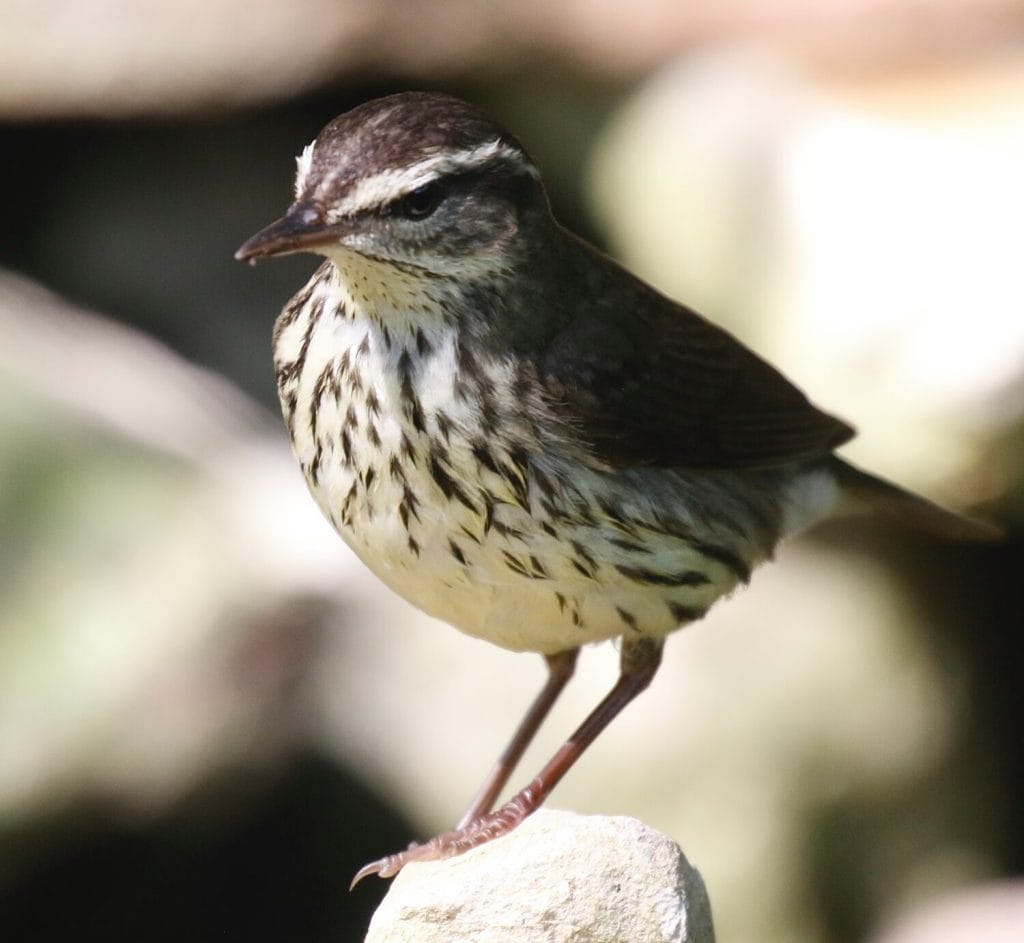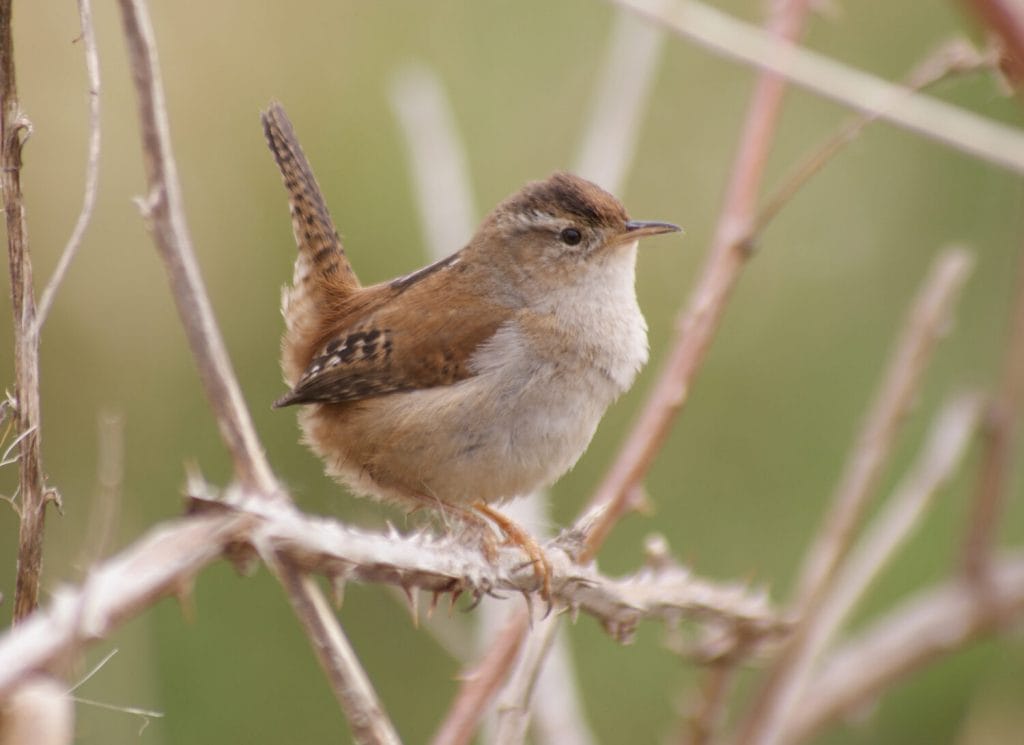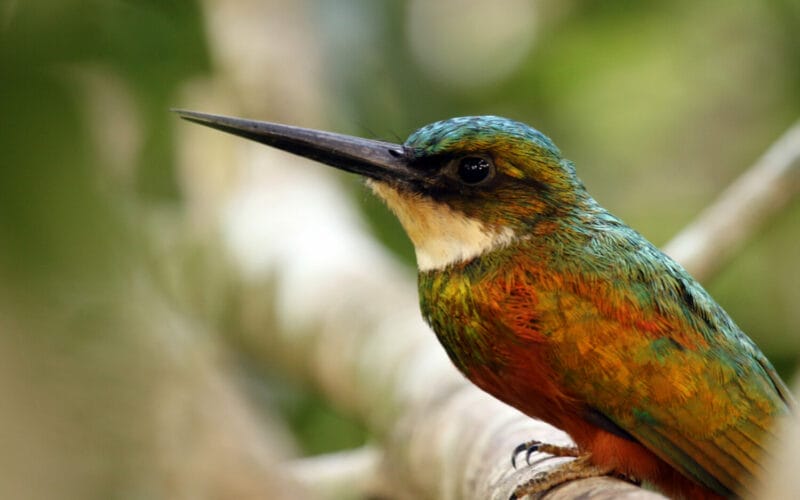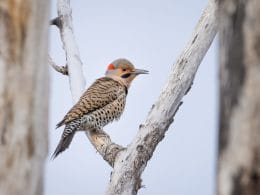In this post, we are moving away from the big and bright birds and going into the undergrowth to find those secretive, camouflaged brown birds. Some, of course, are a bit showier and it is good to see how brown birds can be stunning. Here are our ten of the best brown birds in Florida.

Florida and its Birds
The State of Florida is known for its wetland areas but there are several different types within the state.
- Tidal salt marshes – occurring along the Gulf of Mexico and the Atlantic Coast. Salt marshes are dominated by grasses and rushes that are salt tolerant. They are a rich source of invertebrates and some of the most productive eceosystems in the world.
- Mangrove swamps – found in subtropical coastal areas. In Florida, these are full of red mangrove (Rhizophora mangle) or black mangrove (Avicennia germinans). It is estimated that there are 2,700 square kilometers of such mangroves in Florida.
- Southern swamps – dominated by Cypress. These trees support an understory of vegetation like fetterbush, duckweed and lizard tail. Many of these areas are now protected from logging and development.
- Freshwater marshes – includes the famous Florida Everglades. These are non-tidal systems with waterways surrounded by varieties of grasses. 4,200 square kilometers of Everglades are now protected but still under threat from changes to water cycles caused by human development elsewhere.
- Riparian areas – refers to land adjacent to waterways. These are still classed as wetland because the streams and rivers directly affect the soil and enivronment around them. More mammals like beavers, deer and snakes are present here.
All of these habitats support a myriad of plant and animal life. Most of our birds today can be found skulking around in these areas. Here are our 10 of the best.
Ten of the Best
Brown Pelican (Pelecanus occidentalis)


Identification and Size
Large and unmistakable water bird. Body plumage is gray brown. The neck is variable depending on location and breeding status. May be brown or cream. Bill is either plain gray or bright yellow.
Length: 39.4 – 53.9 inches
Wingspan: 78.8 inches
Weight: 70.5 – 176.4 ounces
Distribution

The Brown Pelican prefers salt water enivronments and so is a coastal bird. Sightings on land may be fly overs or occasionally on inland lakes. As shown in the eBird range map above and distribution chart below, it is a resident and can be seen all year round.

Call
Diet
The Brown Pelican eats fish by diving and scooping them into the pouch under its bill.
Interesting Fact
Pelicans don’t incubate their eggs like most other birds. Rather than sitting on them on a nest, they stand on them and the skin on their feet keeps the eggs warm.
Northern Flicker (Colaptes auratus)


Identification and Size
A striking, large woodpecker with a blend of brown shades across the body. Paler on the front with distinct black spots. Darker on the back with black scallops. A thick black band marks the top of the breast in a crescent shape and the throat is a cinnamon brown with a black or red blob on the side of the mouth. A mid brown thick eyebrow transforms to a grey head and neck. Under the rump is a yellow shaft.
Length: 11 – 12.2 inches
Wingspan: 16.5 – 20.1 inches
Weight: 3.9 – 5.6 ounces
Distribution

This impressive woodpecker is resident in Florida and can be seen across the state, all year round. It lives in open woodland and forests.

Call
Diet
This interesting woodpecker prefers to eat ants. It may take fruits and seeds during the winter months.
Interesting Fact
The Northern Flicker might be a woodpecker but you won’t hear it pecking on trees any time soon. It prefers to eat ants and they are found on the ground!
Grasshopper Sparrow (Ammodramus savannarum)


Identification and Size
This is an attractive sparrow with the usual range of warm mid-brown shades. The tail is compartively short and the breast is a plain buff. A yellow orange patch can be seen above the eye.
Length: 4.5 – 4.5 inches
Wingspan: 7.9 inches
Weight: 0.5 – 0.7 ounces
Distribution

A shy sparrow of open prairies. It can be seen in any appropriate habitat across Florida. It is resident in the state but is more visible in the winter months.

Call
Diet
As the name suggest, this sparrow like grasshoppers. It will eat other insects as well and in winter, will supplement its diet with seeds.
Interesting Fact
The Grasshopper Sparrow nests, rather unusually, on the ground. It prefers clumps of grass and builds a nest in a conical shape.
Dunlin (Calidris alpina)


Identification and Size
A plain gray brown shorebird in non-breeding times. Transforms into a glorious celebration of brown in breeding periods. The belly becomes black and the back is a warm red brown with black spots and streaks. The face remains fairly clean but the cap is rusty. The bill is striking with a droop at the end.
Length: 6.3 – 8.7 inches
Wingspan: 14.2 – 15 inches
Weight: 1.7 – 2.7 ounces
Distribution

The Dunlin inhabits a range of environments in Florida but all have water involved. Estuaries, bogs, peat and coastal grassland are all suitable. This hudsonia subspecies is a common inhabitant of Florida waterways but is more common in the winter months.

Call
Diet
Feeds at fresh and salt water sources eating a range on invertebrates. It may eat vegetation from time to time.
Interesting Fact
The name Dunlin has an interesting origin. It is an old English word which is a combination of dun meaning brown and ing meaning little.
Northern Waterthrush (Parkesia noveboracensis)


Identification and Size
A dark brown back on this thrush blends to a cream and brown streaky breast, which runs up into the throat. A dark face is split with a strong cream eyebrow.
Length: 4.7 – 5.5 inches
Wingspan: 8.9 – 10 inches
Weight: 0.5 – 0.7 ounces
Distribution

Found near water sources in dense shrubbery. Areas may include swamps, bogs and thickets close to water. May be seen in any appropriate enivronment throughout Florida, less likely during summer months.

Call
Diet
Feeds on the ground and takes insects, both adult and larvae. Also eats snails and spiders. This waterthrush may also wade in pools and search vegetation for food.
Interesting Fact
During the winter months the Northern Waterthrush will often roost in groups at night. These sites may be more than a mile from their feeding areas.
Fulvous Whistling-Duck (Dendrocygna bicolor)


Identification and Size
A gorgeous shade of red brown is on the breast and belly of this duck, offset by unusual thick, blue legs and bill. The back is dark and red brown scallops and under the rump is white. Several cream plumes are on the sides.
Length: 17.7 – 20.8
Weight: 15.5 – 37 ounces
Distribution

The Fulvous Whistling Duck can mainly be found in the center of the state. It prefers open areas with some water source. Suitable sites will includes marshes and swamps. It will also inhabit brackish wetlands

Call
Diet
This duck will search suitable habitats for plant and rice seeds. It will also eat aquatic invertebrates.
Interesting Fact
Fulvous Whistling Ducks are very loyal. They bond and will remain in their pairs for many years. Both birds will rear the young.
Varied Thrush (Ixoreus naevius)


Identification
An incredibly stunning thrush. The male is a rich pattern of black and orangey brown. The throat is a deep orange red and is marked by a thick black band on the breast. The belly moves from orange brown into a pale and dark pattern. The back is black on the shoulders and the wings orange and black. Its head is a black cap and cheek with a dark orange eyebrow. The female has similar markings but is less striking with a brown color instead of the black parts.
Length: 7.5 – 10.2 inches
Wingspan: 13.4 – 15 inches
Weight: 2.3 – 3.5 ounces
Distribution

The Varied Thrush is an occasional winter visitor to Florida with few sightings on record. It is a forest bird, preferring dark, shaded and moist areas.

Call
Diet
During winter visits to Florida, the Varied Thrush looks for acorns and berries. It will also take arthropods.
Interesting Fact
The Varied Thrush is a solo bird, not flocking with other species. On occasion it might feed on lawns with American Robins.
Cedar Waxwing (Bombycilla cedrorum)


Identification
The Cedar Waxwing is famed for its beauty, and rightly so. A buffy belly develops into a rich taupe throat and head. Small white markings punctuate the mouth and forehead. A black band runs through the eye and above the bill. The back is a gray brown with small but distinctive red and white patches. The whole effect is brought together with a beautiful crest.
Length: 5.5 – 6.7 inches
Wingspan: 8.7 – 11.8 inches
Weight: 1.1 ounce
Distribution

Found in open woodland areas and around fruit-bearing plants. It can be seen in Florida around the year except for summer and in any appropriate habitat.

Call
Diet
The Cedar Waxwing prefers fruits but will also take flying insects or those it finds on plants.
Interesting Fact
Waxwings are named so for a very specific reason. On some birds, the secondary feathers have a red waxy secretion on the tips. Hence, waxwing. The purpose of this material is unknown.
Brown Thrasher (Toxostoma rufum)


Identification and Size
A thrush-like bird with a long brown tail running into the back and up to the head. The wings are punctuated with black and white spots. The front is a buff colour with brown flecks. A creamy throat blends into a gray head. The eye is a startling yellow.
Length: 9.1 – 11.8 inches
Wingspan: 11.4 – 12.6 inches
Weight: 2.1 – 3.1 ounces
Distribution

The Brown Thrasher prefers thick scrub, forest edges and riparian woodlands. It can be seen throughout the state at any time of year.

Call
Diet
This thrasher will eat insects, prefering beetles. It will also consume arthropods, fruits and nuts.
Interesting Fact
The Brown Thrasher is known for it singing prowess. It has a repertoire of over a thousand songs, including mimicry of many other species.
Marsh Wren (Cistothorus palustris)


Identification and Size
A small but obvious wren with a stiff, erect tail. Mostly a dark brown colour with some darker markings on the wings and end of the tail. The cap is dark with a cream eyebrow. The throat is a pale, buff color.
Length: 3.9 – 5.5 inches
Wingspan: 5.9 inches
Weight: 0.3 – 0.5 ounces
Distribution

The Marsh Wren prefers rushes and marshes and may also be seen in wet fields. It is more visible from October to May in any suitable habitat across the state.

Call
Diet
The Marsh Wren feeds on invertebrates, usually insects and spiders. It will also eat aquatic insects.
Interesting Fact
As is often the case with small birds, the Marsh Wren can be very aggressive. It will fight for food and will regularly kill the hatchlings of other birds and even pierce eggs.
FAQs
Brown Thrashers are larger than other songbirds in Florida and worth lookng for!
Most likely, you are looking at wren. There are several species in Florida. We have featured the Marsh Wren but there is also the Carolina, House, Sedge and Winter Wrens.
This again, is the Brown Thrasher. It does look a bit like a Mockingbird but it is plumper and has a bright eye.
So, that is our pick of the brown birds in Florida. My favorite would be the Brown Thrasher. They are such interesting birds. I will also be on the lookout for the Varied Thrush too. That would be a great sighting.










